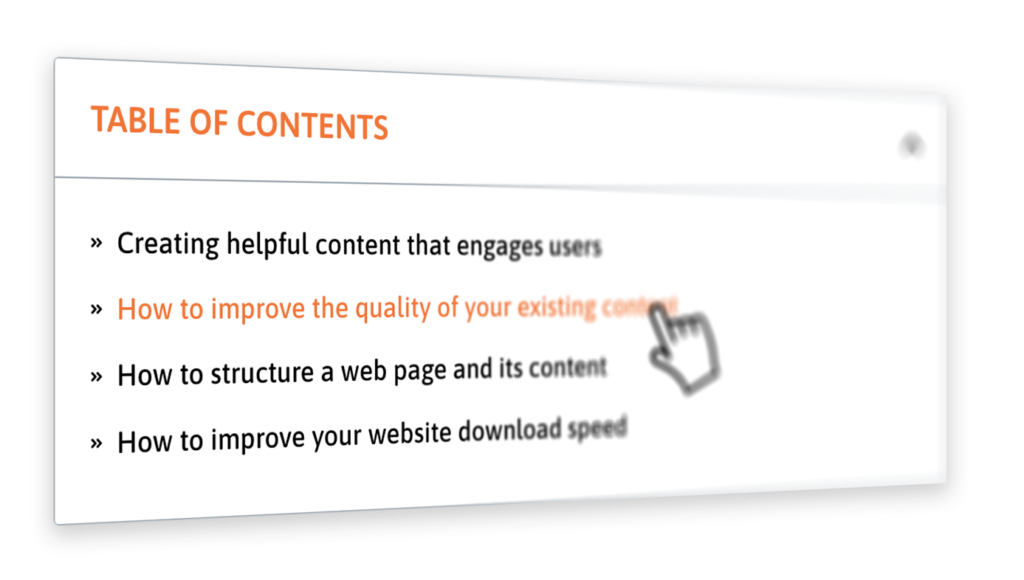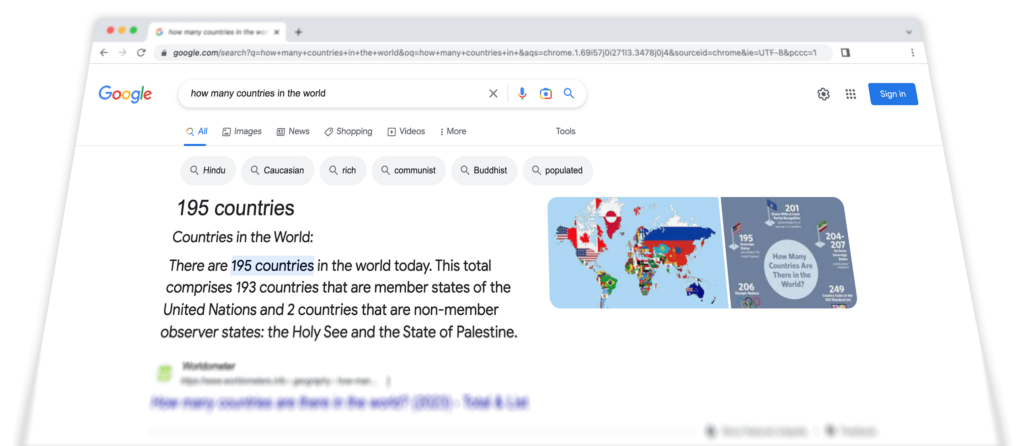CARE HOME SEO & KEYWORD RANKINGS IN 2023
In this article, we’ll be taking a deeper look at some of the fundamentals of Care Home SEO and what you can do in 2023 to improve your keyword rankings and increase the amount of relevant traffic coming to your care home website from search engines.
While this article is mainly about website content, we’ll also be touching on specific technical aspects of SEO, too.
There’s no point adding loads of fresh new interactive content if suddenly you make your website slow to download and unusable.
Creating helpful content that engages users
In 2022 Google introduced the helpful content update “that’s part of a broader effort to ensure people see more original, helpful content written by people, for people, in search results.”
The helpful content update isn’t just a clever campaign by Google to get businesses and organisations to think about content more.
It’s now one of the systems Google runs in the background and uses daily to deliver more query intent-accurate, people-focused search results – and as such, is very much here to stay.
One of the easiest ways to create helpful content and also to improve dwell time across your site and on individual pages is to add interactive content to them.
For example, adding videos to web pages has long been a tried and tested way to not only get your message across but also increase dwell time and improve keyword rankings and your care home SEO.
For the care home sector specifically, another way to add helpful content is by adding a 360 virtual tour.
Giving care seekers the ability to take a tour of your care home from the comfort of their own home is not only a great interactive experience, but it’s also extremely helpful too.
A good 360 virtual tour will visually answer many of the questions care seekers need answers to, before deciding which care home is right for them.
How to improve the quality of your existing content
Here are just four really practical things you can do to improve the quality of your existing content.
1. Identifying and fixing broken links.
Broken links aren’t a great impression to leave prospective clients and they result in 404s which can eat up your crawl budget. There are some free tools that’ll do this for you such as: https://www.deadlinkchecker.com/website-dead-link-checker.asp
2. Checking for and fixing spelling mistakes and grammatical errors.
While there are powerful tools out there which will help you do this, thankfully, there is an easy hack to at least help you identify these errors. Simply copy and paste all the text from a web page, add it into notepad to stripout the formatting and then pop it into MS Word or Google Docs and use their spelling and grammar checks. Repeat the process for all your key content pages and make the changes directly in your CMS.
3. Repurposing content.
Whether it’s an old blog post or a guide you had written a few years ago, first, check your analytics package to see whether the page is yielding organic traffic. If it hasn’t done so for a year or so it’s worth taking a look and seeing if you can refocus and refresh the content into something that’s more relevant. Just delete the old page and 301 redirect that url to the new web page you create.
4. Update existing content frequently.
Much will depend on the amount of resource you have internally for this, but it’s worth doing quarterly reviews and checking for accuracy, relevancy and readability.
How to structure a web page and its content for better care home SEO
Here are a few rules of thumb of how to structure your web page and its content for the benefit of Googlebot (Google’s web crawler) and real human beings – whether they are care seekers at home on their laptops or out and about on their mobile.

The URL
Once you’ve decided on the topic for your web page and identified your focus keyword, always write a keyword-rich URL for it.
One that makes sense when you read it back and is consistent with what the page is about. Try not to use dynamically-generated or numerical URLs as this can have a negative impact on you Care Home SEO.
If in doubt, make the URL the same as the title (h1) tag of your page.
The title tag and meta description
Add your topic or focus keyword to the title tag along with your brand name, such as:
Keyword focus | Brand name
or in this blog’s case
HOW TO IMPROVE CARE HOME SEO
And then add a really strong meta description that contains your focus keyword and entices care seekers to click through to your page.
Make sure you don’t over stuff your title tags or meta descriptions with target keywords as Google ignores poor quality ones – and will choose one for you.
The HTML heading tags
Use one h1 tag, adding your focus keyword, for the title of the page.
Then use h2 and h3 tags for all your subheadings, adding semantic variants of your focus keyword only when it seems natural to do so.

The table of contents links
Create tables of content for information-heavy pages and use bookmark HTML links, also known as jump links, to take users to each section.
They’ll make it easier for users to find the information they want on your page and can help your web page stand out in the search results.
The schema (or structured data)
Schema, or structured data, is simply an extra bit of code you can inject into your web page that helps Googlebot better understand what the content on your page is about for care home SEO purposes.
They can be used by Google to create rich results in its result pages, which are usually at the top of the search results and can result in higher click-through rates.
There are quite a few types of schema available, it’s worth taking a look at and deploying the structured data Google supports to start with.
If you have an FAQ section then the schema is a must-have really. So too with video.
The featured snippet-bait paragraphs, lists, tables and videos
Featured snippets are those paragraphs of text, lists, tables or videos you’ll see at the top of Google’s search results, usually answering a question, how, what, why, where etc.
Google pulls this information from one of the web pages that is in the top 10 for the given search term. If your web page achieves a featured snippet it usually results in an increase in click-throughs – as users tend to trust these answers over the rest.
To achieve a featured snippet make sure you always write clear and concise copy, use short paragraphs with headings as appropriate (see above!) and break up the text on the page with lists and tables.
Oh and adding FAQs with their respective schema really helps too.

How to improve your website download speed
While this is not new advice, it’s still relevant in 2023 for your care home SEO.
Making sure your care home website is quick to download is still a powerful improvement you can make – especially if you’re adding new types of interactive content.
Does download speed really make a difference and how do you start to improve it?
The simple answer is: yes it does.
In a recent study on the download speeds of 143,827 website URLS, Neil Patel commented, “As expected, we confirmed that faster site speed did correlate with higher Google search rankings.”
The best place to start checking whether your site is quick to download is to take a look at the Server Response Times for your homepage.
There are a number of key metrics around this subject, in the above report, Neil Patel identifies one of the most important ones being Time To First Byte (TTFB).
Essentially, when you visit a website or page (URL), your browser sends a request to a server asking for the HTML document at that URL address. TTFB is simply the time it takes the first tiny bit of website data (a byte) to get to your browser from the server.
It’s worth talking with your devs or domain administrator to get them to check the TTFB performance of your homepage against industry benchmarks, which can massively improve your speed and thus Care Home SEO.
Here are a few things you can try to speed things up and which tend to make the most impact in this area.
Use a Content Delivery Network (CDN)
A CDN is a collection of localised servers that work together to deliver content resources, such as images, more quickly and efficiently to users based on their geographic location. Most hosting providers will have deals in place so it’s worth asking the question.
Reducing overall amount of HTTP requests
Another one your developer can help you with, start by by asking them to delete any unnecessary scripts. And, if you’re using WordPress, be sure to delete any unused plugins or find better, less resource heavy, alternatives to the ones you are using.
Upgrade your hosting plan or move to a better host
You might just need more server capacity now than when you first started your business website. Talk to your current host and see what new plans are available. If you can get better elsewhere, make the jump now rather than later.
Summary for Care Home SEO
- Concentrate on quality, interactive content that’s going to help users and is optimised for the web.
- Make sure you structure your web pages and make them easy for users to read and understand.
- Remove the irrelevant stuff that doesn’t add value and instead concentrate on giving users a rich brand and content experience.




